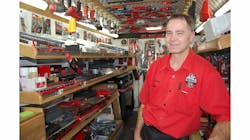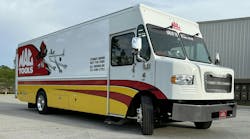There’s no hard sale in Stacey Bleile’s method of delivering products to his shops; he was meant to provide tools to his customers. Bleile makes the customer understand why he should have a tool.
An avid outdoorsman – hunter, fisher, skier and camper – Bleile was born and raised in Calgary, Alberta, Canada, where he worked as an automotive mechanic for more than 25 years: “10 years I worked in small shops. Fifteen years as a mechanic for dealerships.”
Bleile found after years of turning wrenches, he needed a change. “Because of my body, it was taking a beating. It’s hard work. My hip and my shoulder, everything was getting older. I wanted to do something else.”
Bleile is now in his sixth year as a Mac Tools distributor servicing northeast Calgary.
The metro area of Calgary includes close to 1.3 million people, and continues to grow. “When I was growing up, it was about 150,000. Now it’s over 1 million. Everybody’s moving here from all over Canada,” says Bleile.
After only seven months on his route, Mac Tools reached out to Bleile and asked him to become a trainer for other distributors. He has since trained more than 17 distributors (and counting) all over Alberta and British Columbia.
Bleile has about 700 customers on the books that buy from him regularly. He prides himself on being a top seller for Mac Tools, and has bought almost $400,000 in inventory this year alone.
Add to that the additional $250,000 Bleile has purchased so far for his other two routes – run by brother Jim Bleile, and long-time family friend Dwayne Melnyk – he hopes to come close to the $1 million mark by the end of the year, and exceed that for 2015.
He’s grown his business by 20 percent every year. This year alone, he’s up 28 percent from 2013. Bleile has been recognized as one of the top three distributors for Mac Tools in North America, and has already reached the Platinum Elite level.
A day in the life
Stacey prides himself on honesty and no-pressure sales, and remains non-confrontational with his approach to customers. “I don’t sell them something they don’t need,” says Bleile.
Because he worked as a technician for so long, he often lends a hand to his customers by assisting with troubleshooting vehicle issues they may have in the shop. He’s careful not to overstep his bounds, and will generally only provide diagnoses help if a customer asks him a question.
Bleile uses his own knowledge and understanding of how to repair vehicles to maintain and fix his own truck as well.
“In all the years I’ve been doing this, you’ll very rarely see me off the road for a repair,” says Bleile.
“I listen to my truck. I’m always looking at it, under it. Usually I can see something before it actually happens, and then I get it fixed. Very rarely will you see me off the road.”
“That’s what will kill people too. If you get a bad truck or a truck that’s not maintained, then you’re off the road and now you’re making no money.”
He approaches each shop, and every customer, exactly the same. He focuses on reaching out to everybody he’s sees in the shop, even if they’re not his customer. For many of his stops, Bleile is the exclusive distributor that his customers buy from.
“I go in and talk to everybody. I try not to miss anybody,” says Bleile. He also makes it a point to talk to the shop managers and shop owners.
His normal approach involves asking each customer how the tools he has sold are working out, and if the customer has any warranties that need attention. He is quick to offer a solution or part to fix a tool, before replacing the item.
And after every conversation, he says, “I’ll see you next week.” Bleile sticks to this mantra, because he’s focused on the long term.
“I’m not doing this for one week. I’m doing this to keep everybody happy. If you’re going out every week, you want to sell every week,” he says. “They’ll be back next week, instead of forcing it down their throat (today). But if you force it down their throat, they might not be back next week.”
Before going in to each shop, Bleile prepares himself by reviewing his printed “customer needs” list, to gather any orders that have come in for customers at the shop. He’ll also verify who owes him.
“When you get into these big places where there are 40 or 50 guys, sometimes you get bombarded, and you want to be organized or guys are getting on edge because you’re talking to someone else and they’re standing there waiting to make a payment,” says Bleile. “If you’re organized and efficient, you can tell they appreciate it.”
His usual approach involves getting a few customers on the truck at a time, so he can focus in on their needs before bringing other customers out.
Working with customers
Asked about the best part of his job, it’s no surprise on Bleile’s answer: his customers.
When Bleile approaches new customers, his decision to work with them is based on intuition when he first meets the technician.
“I’m pretty good with feeling guys out. Guys that take off and don’t pay, I’ve got very few of those,” he says. When Bleile takes on a new customer, he makes sure to train the customer on how, when and why payments should be made.
“I’ll tell them what I expect, I’ll shake their hand and explain this is how I like to do my payments.”
He also determines when each independent shop or dealership has a payday, so he can expect payments during those weeks. He provides flexibility on payments if necessary, only after he has an established relationship with a customer.
Many of his customers cut a check weekly, during payday or pay off the balance completely once it reaches a certain amount.
He allows the option of paying by cash, check or credit, and never keeps credit card numbers on file. He’ll receive the card from the customer for a separate transaction every time.
“A lot of guys live paycheck to paycheck, so they don’t have a lot of money. They all want to pay me every payday, which is fine.”
With this payment plan structure in place, Bleile consistently maintains an average below five-week turns.
“That’s the hardest part about this job, is collections. If you can train your guys on how to pay, then you don’t have any issues.”
He also advises he’s conscious of making sure customer account balances don’t get too high.
“A lot of guys like me because of that,” says Bleile. “They’ll get something, pay it off. Get something else, pay that off.”
This can also be beneficial because it keeps his turns down, and allows him to pay off his bill more easily.
Bleile says it’s important to balance out the amount sold to a customer, compared to how much they owe. Bleile has about $60,000 on the street at any given time.
“If you leave that money out a long, long time, people start to quit. There’s a reason you want to collect within five or six weeks. Unless you’re selling them a toolbox and you know the guys been here six years, and you know he’s not going anywhere,” says Bleile. “You have to weigh that out.”
Bleile will also provide financing out of his own pocket for larger transactions, if he trusts the customer and as worked with him for a long time.
Sales and stocking strategies
Bleile continually changes up his sales strategies. “If you don’t change, you don’t get better,” he says. “You just get stale.”
Sometimes, Bleile leaves a tool ordered by a customer on the truck. He’ll go into the shop and advise his customer that the tool is in, and to stop out on the truck to pick the tool up.
“Or I’ll reverse it, and I’ll carry the (tool) in for that person, but I won’t go to that person,” says Bleile. “I’ll see everybody else while I’m holding the stuff in my arm.” He says other customers will consistently ask about the tool Bleile is carrying around, before he delivers it to the original purchaser.
Bleile finds it’s a balancing act between having the right tools and keeping shelves stocked. He doesn’t overstock his shelves to ensure customers can see all of the products he has to offer. This also aids in not having as much overhead.
He also recommends changing where tools are on the truck from time to time.
“You’ve got to change it because some people are impulse buyers, so they’ll come on, look around and see something they want. Then they’ll buy it,” says Bleile.
Uniquely Canadian
Independent shops have to become certified to conduct province safety inspections. This requires shops to have certain tools for inspections, which Bleile can sell to customers. The government mandates the required equipment, and will survey shops every two years to ensure each business has the proper tools in the shop.
“We don’t have emissions here yet. But it’s right around the corner. Which is bad for shops, because they’re going to have to get more equipment,” says Bleile. But he goes on to advise he’ll be able to sell the necessary tools and equipment to shops if and when emission inspections become a required practice for shops.
Of issues Bleile faces, he commented on the longer turnaround for shipped orders from the United States. He’s learned to handle this by giving his customers a two-week window for receiving special orders, to ensure the product is delivered on time.
“I set them up for it so that’s what they’re prepared for, and they don’t come back asking about the tool,” says Bleile.
Help from the family
Bleile says he tries to submit orders as soon as he talks with his customer, but he doesn’t always get the chance while he’s running his route. He spends every evening preparing for the next day, most evenings with the help of his wife, Brenda.
“We do everything at home. My wife comes out (to the truck), we finish up and she’s counting the day’s money out and starts putting tools away (from previous days/weeks order) while I’m placing orders,” says Bleile. “It’s all good.”
“I help quite a bit, otherwise we would never see him,” says Brenda.
Brenda assists with organizing the orders that have come in that day, counting inventory, restocking the truck and counting down the till.
The Bleiles are also on friendly terms with the delivery service. The delivery person has the garage code to deliver larger items, such as toolboxes, if Brenda isn’t home for a portion of the day.
This routine, along with Bleile’s acute attention to maintaining not only his family relationships, but also his customer relationships, has helped him succeed.
He is quick to assist any of his customers with small tasks or fixes, because he knows it helps with building and maintaining long-term relationships with them. His goal remains to not only provide shops with their tool and equipment needs, but also to provide exceptional service while he does it.


